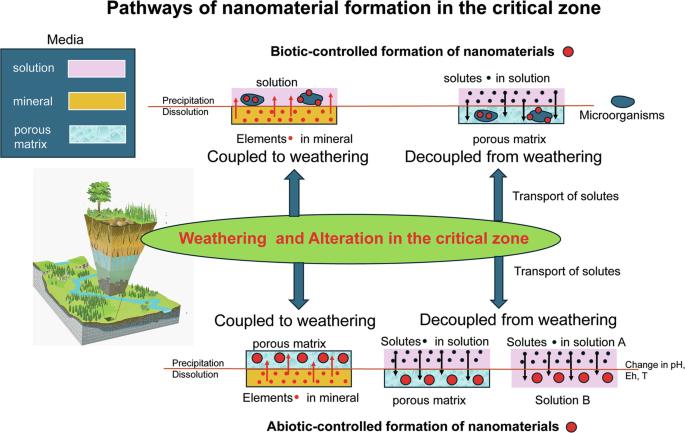地球纳米材料循环中由非生物和生物控制的纳米材料形成途径。
IF 8.1
1区 地球科学
Q1 ENVIRONMENTAL SCIENCES
引用次数: 0
摘要
纳米材料具有独特的性质,在地球上元素的预算、循环和化学处理中发挥着至关重要的作用。如果能清楚地认识和了解纳米材料的形成途径,就能大大提高对纳米材料循环的理解。在这里,我们展示了由水流介导的纳米材料形成途径可分为四大类,即与风化过程耦合和脱钩的非生物和生物过程。这些过程又可细分为 18 个与临界区以及海洋热液喷口和上地幔等环境相关的子类别。同样,气相中的途径,如火山热气孔、野火以及平流层和对流层中的粒子形成,可分为两大类和五个子类。从最基本的意义上讲,水-流体和气相途径都有助于了解所有矿物的形成,而这些矿物的形成本质上都是基于纳米级的前体和反应。本文章由计算机程序翻译,如有差异,请以英文原文为准。

Abiotic and biotic-controlled nanomaterial formation pathways within the Earth’s nanomaterial cycle
Nanomaterials have unique properties and play critical roles in the budget, cycling, and chemical processing of elements on Earth. An understanding of the cycling of nanomaterials can be greatly improved if the pathways of their formation are clearly recognized and understood. Here, we show that nanomaterial formation pathways mediated by aqueous fluids can be grouped into four major categories, abiotic and biotic processes coupled and decoupled from weathering processes. These can be subdivided in 18 subcategories relevant to the critical zone, and environments such as ocean hydrothermal vents and the upper mantle. Similarly, pathways in the gas phase such as volcanic fumaroles, wildfires and particle formation in the stratosphere and troposphere can be grouped into two major groups and five subcategories. In the most fundamental sense, both aqueous-fluid and gaseous pathways provide an understanding of the formation of all minerals which are inherently based on nanoscale precursors and reactions. The formation of nanomaterials in aqueous fluids can be explained by four different pathways: formation by biotic and abiotic processes, coupled and decoupled with weathering processes. In the Earth’s critical zone, these pathways can be classified into 18 subcategories based on the surrounding environment.
求助全文
通过发布文献求助,成功后即可免费获取论文全文。
去求助
来源期刊

Communications Earth & Environment
Earth and Planetary Sciences-General Earth and Planetary Sciences
CiteScore
8.60
自引率
2.50%
发文量
269
审稿时长
26 weeks
期刊介绍:
Communications Earth & Environment is an open access journal from Nature Portfolio publishing high-quality research, reviews and commentary in all areas of the Earth, environmental and planetary sciences. Research papers published by the journal represent significant advances that bring new insight to a specialized area in Earth science, planetary science or environmental science.
Communications Earth & Environment has a 2-year impact factor of 7.9 (2022 Journal Citation Reports®). Articles published in the journal in 2022 were downloaded 1,412,858 times. Median time from submission to the first editorial decision is 8 days.
 求助内容:
求助内容: 应助结果提醒方式:
应助结果提醒方式:


